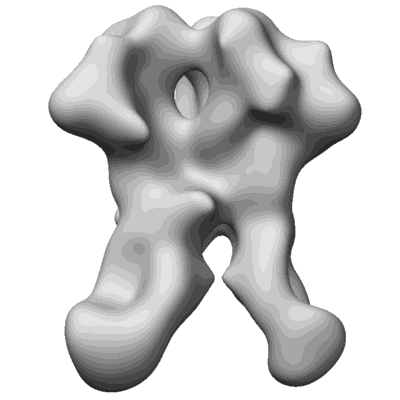EMD-23180
nsEM maps of BG505 SOSIP.v5.2(7S) in complex with the polyclonal Fab samples from Group 3 of immunized rhesus macaques (Wk38 time point; Animal IDs: Rh.33172, Rh.34919, Rh.34167, Rh.33065, Rh.34725)
EMD-23180
Single-particle20.0 Å
 Deposition: 22/12/2020
Deposition: 22/12/2020Map released: 04/08/2021
Last modified: 23/11/2022
Sample Organism:
Human immunodeficiency virus 1
Sample: BG505 SOSIP.v5.2(7S) in complex with the polyclonal Fab samples from Group 3 of immunized rhesus macaques (Wk38 time point; Animal IDs: Rh.33172, Rh.34919, Rh.34167, Rh.33065, Rh.34725)
Deposition Authors: Antanasijevic A, Sewall LM, Ward AB
Sample: BG505 SOSIP.v5.2(7S) in complex with the polyclonal Fab samples from Group 3 of immunized rhesus macaques (Wk38 time point; Animal IDs: Rh.33172, Rh.34919, Rh.34167, Rh.33065, Rh.34725)
Deposition Authors: Antanasijevic A, Sewall LM, Ward AB

Polyclonal antibody responses to HIV Env immunogens resolved using cryoEM.
Antanasijevic A,
Sewall LM,
Cottrell CA  ,
Carnathan DG,
Jimenez LE,
Ngo JT,
Silverman JB
,
Carnathan DG,
Jimenez LE,
Ngo JT,
Silverman JB  ,
Groschel B,
Georgeson E
,
Groschel B,
Georgeson E  ,
Bhiman J,
Bastidas R,
LaBranche C
,
Bhiman J,
Bastidas R,
LaBranche C  ,
Allen JD
,
Allen JD  ,
Copps J
,
Copps J  ,
Perrett HR
,
Perrett HR  ,
Rantalainen K
,
Rantalainen K  ,
Cannac F,
Yang YR,
de la Pena AT,
Rocha RF,
Berndsen ZT,
Baker D
,
Cannac F,
Yang YR,
de la Pena AT,
Rocha RF,
Berndsen ZT,
Baker D  ,
King NP
,
King NP  ,
Sanders RW,
Moore JP
,
Sanders RW,
Moore JP  ,
Crotty S
,
Crotty S  ,
Crispin M
,
Crispin M  ,
Montefiori DC,
Burton DR
,
Montefiori DC,
Burton DR  ,
Schief WR
,
Schief WR  ,
Silvestri G,
Ward AB
,
Silvestri G,
Ward AB 
(2021) Nat Commun , 12 , 4817 - 4817
 ,
Carnathan DG,
Jimenez LE,
Ngo JT,
Silverman JB
,
Carnathan DG,
Jimenez LE,
Ngo JT,
Silverman JB  ,
Groschel B,
Georgeson E
,
Groschel B,
Georgeson E  ,
Bhiman J,
Bastidas R,
LaBranche C
,
Bhiman J,
Bastidas R,
LaBranche C  ,
Allen JD
,
Allen JD  ,
Copps J
,
Copps J  ,
Perrett HR
,
Perrett HR  ,
Rantalainen K
,
Rantalainen K  ,
Cannac F,
Yang YR,
de la Pena AT,
Rocha RF,
Berndsen ZT,
Baker D
,
Cannac F,
Yang YR,
de la Pena AT,
Rocha RF,
Berndsen ZT,
Baker D  ,
King NP
,
King NP  ,
Sanders RW,
Moore JP
,
Sanders RW,
Moore JP  ,
Crotty S
,
Crotty S  ,
Crispin M
,
Crispin M  ,
Montefiori DC,
Burton DR
,
Montefiori DC,
Burton DR  ,
Schief WR
,
Schief WR  ,
Silvestri G,
Ward AB
,
Silvestri G,
Ward AB 
(2021) Nat Commun , 12 , 4817 - 4817
Abstract:
Engineered ectodomain trimer immunogens based on BG505 envelope glycoprotein are widely utilized as components of HIV vaccine development platforms. In this study, we used rhesus macaques to evaluate the immunogenicity of several stabilized BG505 SOSIP constructs both as free trimers and presented on a nanoparticle. We applied a cryoEM-based method for high-resolution mapping of polyclonal antibody responses elicited in immunized animals (cryoEMPEM). Mutational analysis coupled with neutralization assays were used to probe the neutralization potential at each epitope. We demonstrate that cryoEMPEM data can be used for rapid, high-resolution analysis of polyclonal antibody responses without the need for monoclonal antibody isolation. This approach allowed to resolve structurally distinct classes of antibodies that bind overlapping sites. In addition to comprehensive mapping of commonly targeted neutralizing and non-neutralizing epitopes in BG505 SOSIP immunogens, our analysis revealed that epitopes comprising engineered stabilizing mutations and of partially occupied glycosylation sites can be immunogenic.
Engineered ectodomain trimer immunogens based on BG505 envelope glycoprotein are widely utilized as components of HIV vaccine development platforms. In this study, we used rhesus macaques to evaluate the immunogenicity of several stabilized BG505 SOSIP constructs both as free trimers and presented on a nanoparticle. We applied a cryoEM-based method for high-resolution mapping of polyclonal antibody responses elicited in immunized animals (cryoEMPEM). Mutational analysis coupled with neutralization assays were used to probe the neutralization potential at each epitope. We demonstrate that cryoEMPEM data can be used for rapid, high-resolution analysis of polyclonal antibody responses without the need for monoclonal antibody isolation. This approach allowed to resolve structurally distinct classes of antibodies that bind overlapping sites. In addition to comprehensive mapping of commonly targeted neutralizing and non-neutralizing epitopes in BG505 SOSIP immunogens, our analysis revealed that epitopes comprising engineered stabilizing mutations and of partially occupied glycosylation sites can be immunogenic.
